SLUP414 April 2024
1 Introduction
Today’s power-conversion systems demand high efficiency, high power density and lighter weight. In telecommunication, server and PC applications, the 80 Plus certification program has defined efficient power-supply standards for over 15 years. Recently, the Open Compute Project (OCP) announced the M-CRPS specification for server power-supply units (PSUs), which requires even higher efficiency requirements than 80 Plus, as shown in Table 1.
| Efficiency at | 10% load | 20% load | 50% load | 100% load | Note |
|---|---|---|---|---|---|
| 80 Plus Titanium | 90% | 94% | 96% | 91% | @230-VAC input |
| M-CRPS (<2,500 W) | 90% | 94% | 96% | 92% | @240-VAC input |
| M-CRPS (≥2,500 W) | 90% | 94% | 96% | 94% | @240-VAC input |
Part of the reason why a PSU needs to have higher efficiency is because of the need for energy-efficient data centers. In data centers less than a decade old, the power usage effectiveness (PUE) is about 3, where PUE is defined in Equation 1 as:
The lower the PUE, the more efficient the data center.
Figure 1 and Figure 2 break down the power consumption of two data centers with a PUE equal to 3 and 1.25, respectively. For the data center with the PUE equal to 3, because a large portion of total data center power is powering the cooling system, increasing server PSU efficiency will definitely help reduce the cooling power needed, reducing the PUE and increasing efficiency.
 Figure 1 Data center (PUE = 3) power
consumption breakdown.
Figure 1 Data center (PUE = 3) power
consumption breakdown. Figure 2 Data center (PUE = 1.25) power
consumption breakdown.
Figure 2 Data center (PUE = 1.25) power
consumption breakdown.Not only is higher efficiency mandatory, but server PSUs must deliver more power in a smaller footprint given the emergence of artificial intelligence (AI) and edge computing, along with the continuation of Moore’s law. Server loads including the CPU and graphics processing unit (GPU) require much more power, as the transistors per process unit are increasing exponentially. While server rack size remains the same, server PSUs must have higher power density to meet server load power demands.
High power density is also a requirement for automotive and aerospace applications, as lighter weight means that transportation carriers will have better energy efficiency.
Inside the PSU, one way to reduce weight is to increase the converter switching frequency, which then reduces the magnetic volt-seconds and therefore its size. Figure 3 plots transformer volume versus switching frequency. An onboard charger with a DC/DC converter switching frequency of 500 kHz will have a transformer with less than half the volume of a 100-kHz transformer.
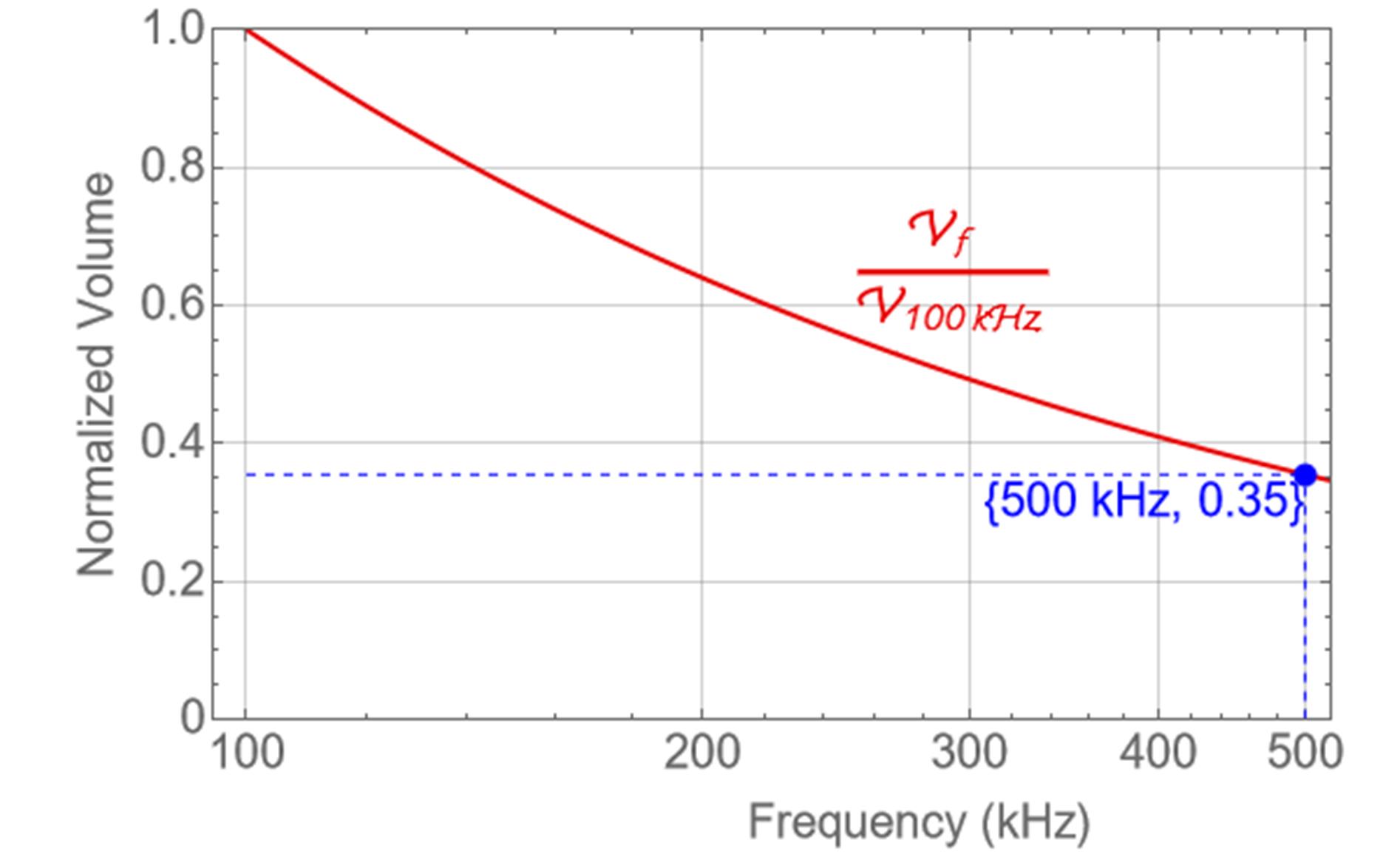 Figure 3 Transformer volume vs. switching
frequency.
Figure 3 Transformer volume vs. switching
frequency.Because the goal is to have higher power density without compromising efficiency, it is essential to introduce soft switching in the PSU to reduce switching losses. Hard-switched converters were first developed in switch-mode power supplies, which have metal-oxide semiconductor field-effect transistor (MOSFET) current and voltage overlapping at the MOSFET turnon transient, as shown in Figure 4. A higher switching frequency means more frequent hard-switching transients, and therefore more switching losses. Although it is possible to reduce switching losses by increasing the turnon speed to reduce the overlapped area, a higher voltage-changing slew rate will result in higher noise and electromagnetic interference levels. On the other hand, allowing the negative drain-to-source current to discharge the MOSFET output capacitor (Coss) voltage before the gate voltage goes high does achieve soft-switched turnon, as shown in Figure 5. The lack of current and voltage overlap at the MOSFET turnon transient results in no turnon switching losses, which allows the PSU to operate at a high switching frequency and maintain high efficiency at the same time.
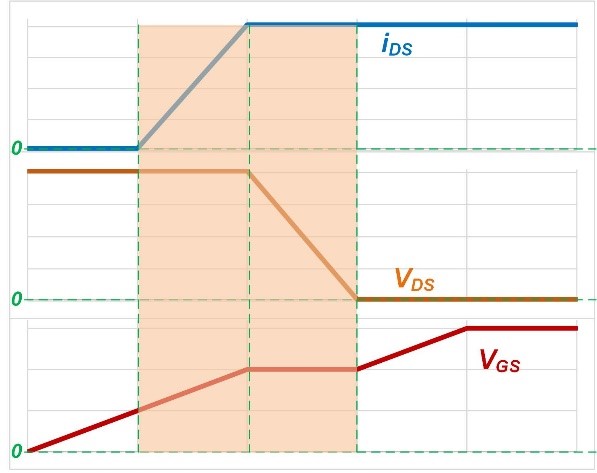 Figure 4 MOSFET hard-switching turnon
transient.
Figure 4 MOSFET hard-switching turnon
transient.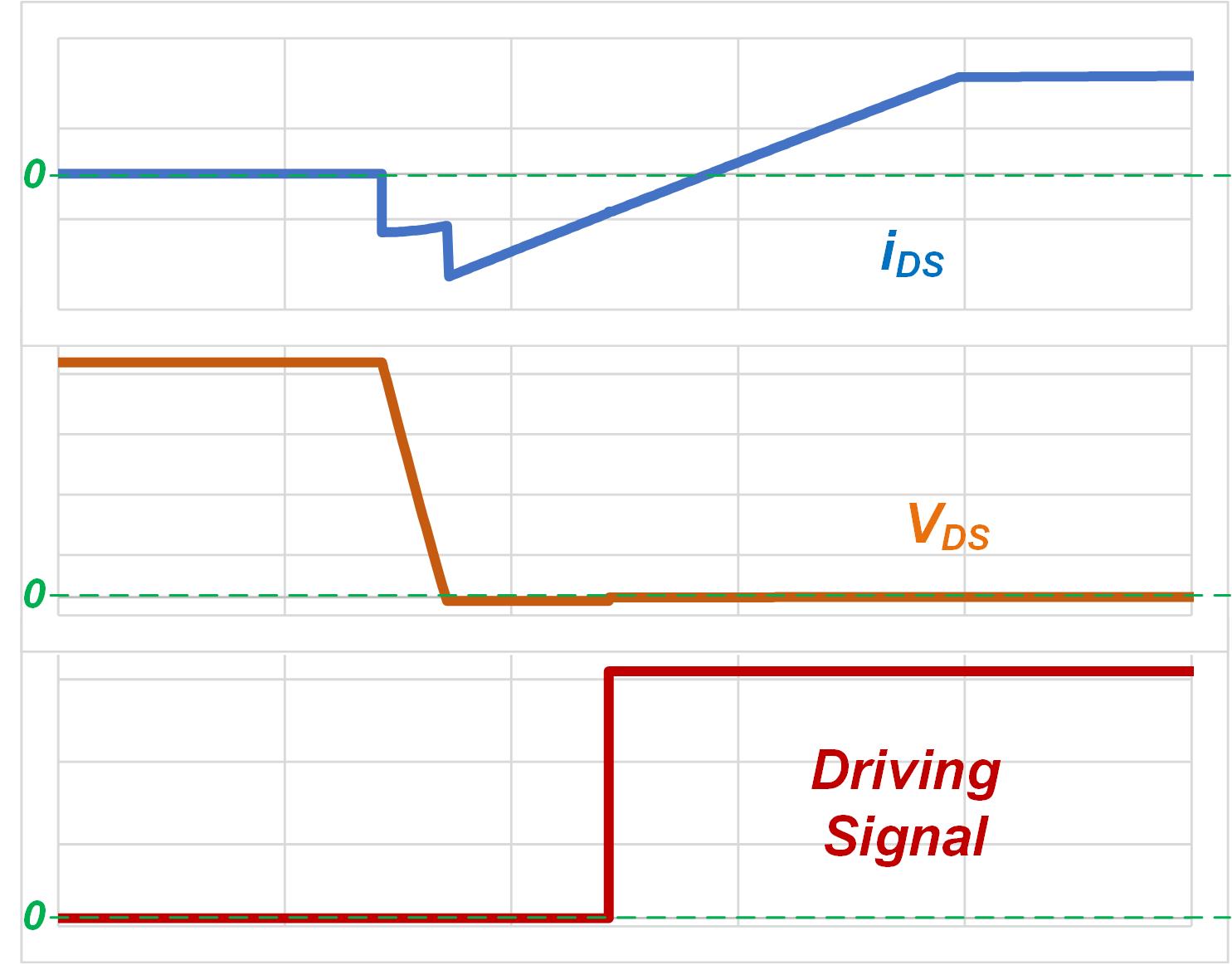 Figure 5 MOSFET soft-switching turnon
transient.
Figure 5 MOSFET soft-switching turnon
transient.The same topology with a different control method could result in different behaviors at MOSFET switching transients. Take the full-bridge converter in Figure 6 as an example. If you were to operate the full-bridge converter with pulse-width modulation (PWM) control, the converter would exhibit hard switching behavior at the MOSFET turnon transient; the MOSFET drain-to-source current starts from positive at the turnon transient.
Figure 7 shows the most significant hard-switched full-bridge converter MOSFET voltage and current waveforms, where nonzero voltage and current overlap at the switching transient, as highlighted by the green dashed-line circle. When operating the full-bridge converter with phase-shift control between the two input legs, a negative drain-to-source current during the MOSFET turnon transient will avoid nonzero voltage current overlapping for soft switching, as shown in Figure 8.
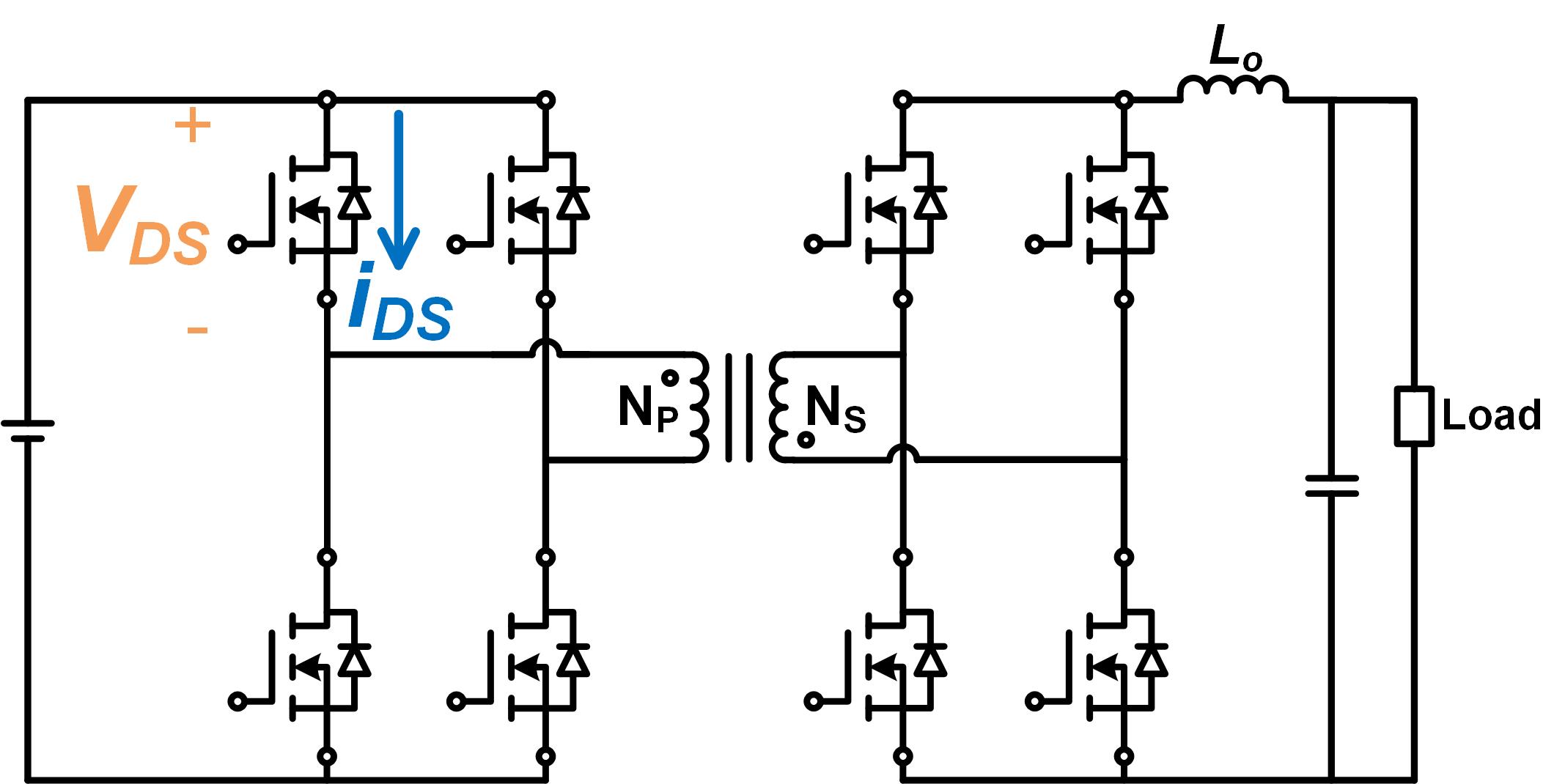 Figure 6 Full-bridge converter.
Figure 6 Full-bridge converter.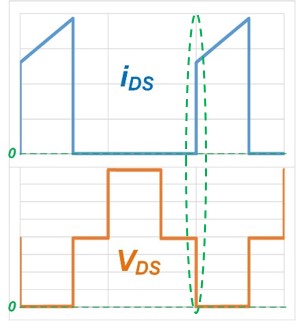 Figure 7 Hard-switched full-bridge MOSFET
current and voltage.
Figure 7 Hard-switched full-bridge MOSFET
current and voltage.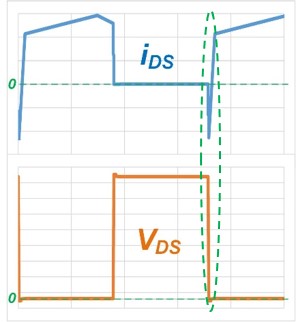 Figure 8 PSFB MOSFET current and
voltage.
Figure 8 PSFB MOSFET current and
voltage.A PFSB converter, inductor-inductor-capacitor (LLC) series resonant converter (SRC) and dual active bridge (DAB) converter can all achieve soft switching, but with different characteristics. An LLC-SRC uses frequency modulation for voltage regulation, while a PSFB and DAB both use phase-shift control with a fixed switching frequency for voltage regulation. An LLC-SRC is the only converter among these three that can achieve soft switching on the output rectifier; it usually has higher peak efficiency than the PSFB or DAB in most cases.
An LLC-SRC isn’t a good option for applications with wide input or output ranges, however. For an LLC-SRC to cover wide input or output ranges, you will have to decrease the ratio of the transformer magnetizing inductance to the resonant inductance, which will result in an efficiency reduction. A PSFB and DAB can cover wide input or output ranges with a wide effective duty-cycle (Deff) range without as much of an efficiency reduction penalty as an LLC-SRC. Moreover, peak current-mode control for a PSFB is more mature than current-mode control in an LLC-SRC for fast response to load transients. A PSFB is also the preferred choice in applications with fast transient response requirements. PSFB applications include server PSUs for AI and edge computing with fast load transients as well as battery charger applications, including electric vehicle 400-V, 800-V to 12-V battery power-conversion systems with wide input and output ranges.
In this topic, we will describe the fundamentals of a PSFB including operational principles, rectifier options, clamping options and different types of controls, along with a design example.